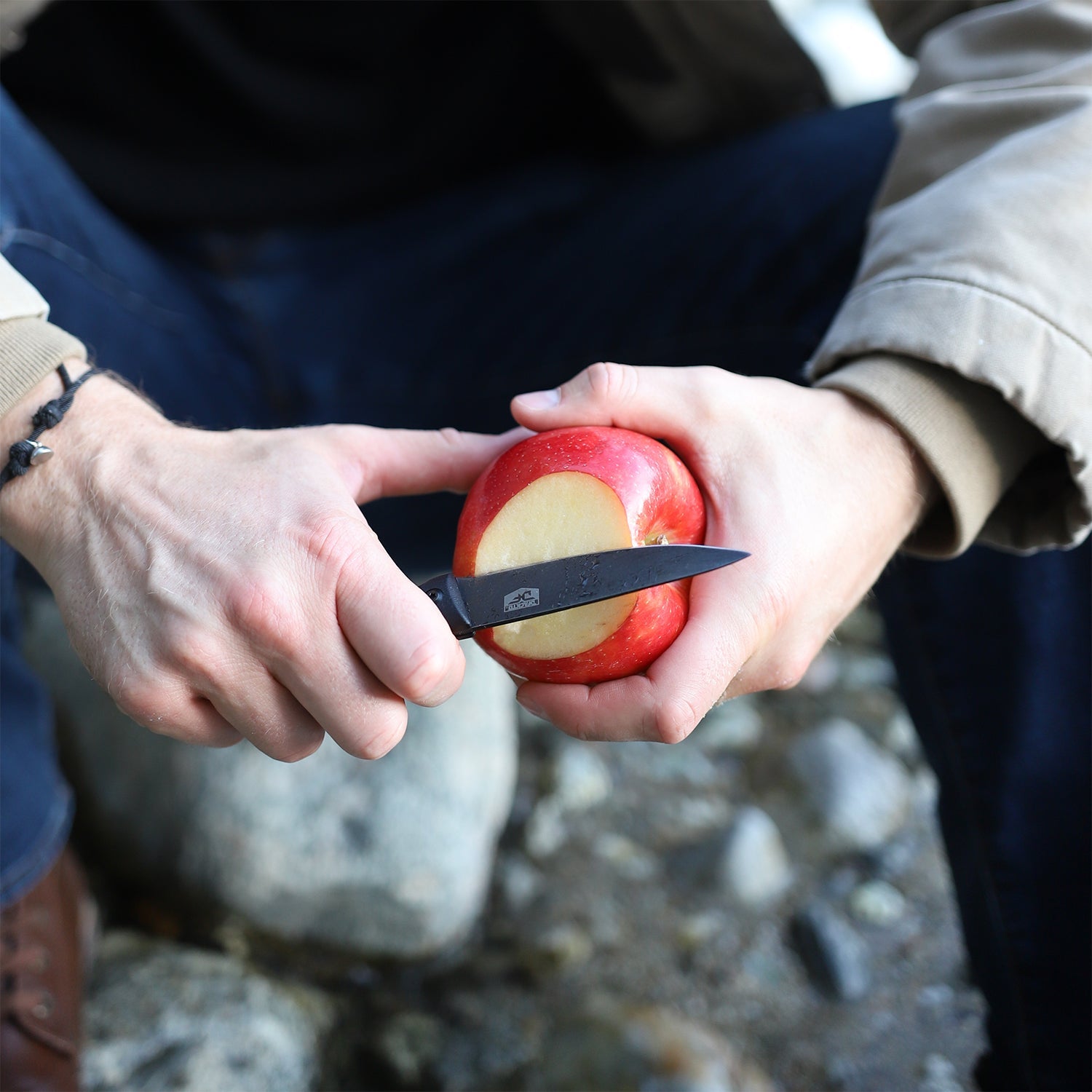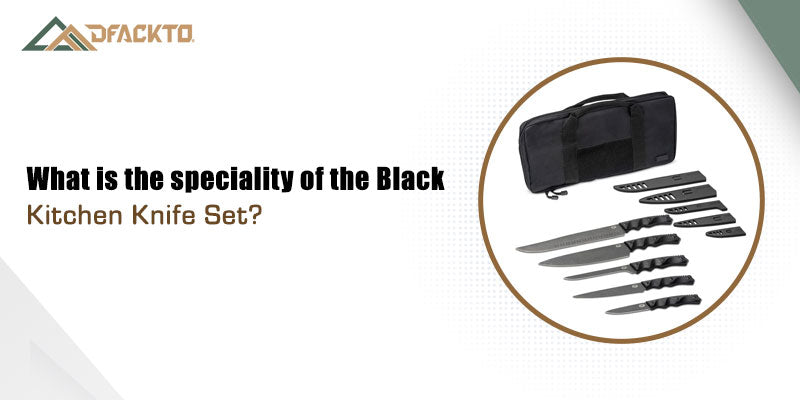When you're deep in the wilderness with nothing but your gear, your skill, and your appetite, there’s one tool that has to rise above the rest: your knife.
Food preparation in a camping environment isn’t just about slicing sausages or peeling carrots. It’s about field-dressing wild game, cleaning fresh-caught fish, chopping root vegetables on a stump, and splitting open squash beside the fire. When the setting is harsh, unpredictable, and far from modern conveniences, your culinary tools must be as rugged and versatile as the terrain you're in.
Let’s get one thing straight: those heavy “Serbian cleaver” style chopping knives are all hype. They’re clunky, hard to control, and more suited for Instagram than real backcountry prep. And don’t get us started on oversized, gimmicky “Rambo” survival knives. A true bushcraft food-prep blade is compact, efficient, and versatile—exactly like a fixed-blade trailing point such as the DFACKTO Interceptor 3.5" Paring Knife.
While marketed as a paring knife, its utility goes far beyond delicate kitchen work. It’s a no-nonsense tool for trimming, slicing, and cleaning in the wild—small in size, massive in capability.
Why Your Camping Knife Needs to Do More
A typical kitchen knife just won’t cut it in the backcountry. Standard blades are built for clean countertops and sanitized prep stations. But camping conditions are chaotic, unpredictable, and dirty—and your tools must match that energy.
A true camping food prep knife should:
- Withstand moisture, dirt, grime, and high impact
- Hold an edge through tough use
- Feature a full-tang for maximum durability
- Offer a grip that remains firm even when wet or greasy
- Be easy to clean and pack
- Offer versatility: trimming, slicing, skinning, boning, chopping, and more
Key Traits of a Backcountry-Ready Culinary Knife
Durability
A camp knife needs to be more than sharp—it must be unbreakable under stress. Look for high-carbon stainless steel and full-tang construction. These features ensure the knife won’t snap, bend, or corrode after a few wet mornings and hard cuts.
Control in Wet Conditions
Whether you're handling raw meat, wet vegetables, or just caught a trout, a slip-resistant grip is essential. Textured, ergonomic handles make a real difference when it’s cold, rainy, or your hands are greasy with fat.
Blade Shape That Matches the Task
The wrong blade shape will wear you out fast. For camping food prep, versatile designs like:
- Trailing point blades for fine slicing and precision
- Curved boning blades for game and fish
- Robust chef-style blades for general chopping
…are all far more useful than oversized, bulky “tactical” knives. Think function over flash.
Easy Storage & Mobility
At camp, gear weight matters. Knives that come with sheaths, compact rolls, or portable cases are a win. Bonus if they can be cleaned easily and re-sharpened without fancy tools.
Essential Knives for Wilderness Cooking
Whether you’re cooking a single trout over an open fire or preparing a full meal for ten, here’s a breakdown of the essential knives you’ll want in your kit.
8" Chef Knife (or Field Kitchen Knife)
This is your backcountry workhorse. You’ll use it to chop onions, cut meat, split squash or potatoes, and mince herbs. Choose one with a balanced weight and a durable spine that can withstand rougher camp cutting surfaces.
6" Hybrid Boning/Fillet Knife
For trimming silver skin, breaking down meat, cleaning fish, or even slicing fruit, a hybrid boning knife with some curve and flex is essential. It gives you precision with just enough power.
3.5" Fixed Blade Paring/Utility Knife
A compact blade lets you do detailed work like cleaning game birds, trimming fat, or slicing sausage. When designed right, a small knife can be your most-used tool in camp—fast, nimble, and versatile.
10" Butcher Knife (Optional)
If you’re in hunting territory or prepping meals for a group, a butcher knife is a solid add-on. It helps process large cuts of meat, split through tough veggies, or portion roasts efficiently.
Ergonomics and Safety in the Outdoors
One of the biggest differentiators in outdoor food prep is comfort and control. In the field, you’re often standing, squatting, or working off unstable surfaces. A knife that slips or causes hand fatigue can be frustrating—or dangerous.
Knives designed with finger-hold systems, textured grips, and palm-fitting contours will reduce wrist fatigue and improve efficiency. These features aren’t just nice to have—they can make or break your outdoor cooking experience.
Knife Care Tips for the Campsite
- Clean often, dry immediately. Even stainless blades benefit from quick cleaning and drying after each use.
- Sharpen as needed. A pocket sharpener or field stone can keep your edge fresh.
- Store safely. Use a sheath or case to protect the blade and avoid accidents in your pack.
A Note on Style and Substance
The modern outdoorsman expects more than just utility. There's a new generation of gear heads and camp chefs who want tools that perform and look good doing it. Aggressive styling, stonewashed finishes, and gear-ready packaging aren’t just fashion—they reflect the mindset of those who embrace the wild with confidence.
If you're looking for culinary tools that don’t just mimic the professional kitchen but are reimagined for the wild, there are emerging brands on the market stepping up. Some have even earned military contracts for their tactical culinary gear. These companies are combining professional kitchen performance with field-ready toughness, and it’s worth exploring beyond traditional names.
Final Thoughts: Choose Tools That Match Your Environment
Backcountry food prep is about more than filling your stomach—it’s part of the ritual of survival, camaraderie, and adventure. The knives you choose should reflect that.
So what kind of knife is best for camping food preparation?
- One that’s durable, versatile, and secure in your hand
- One that performs equally well on a game animal or a tomato
- One that’s built to handle the mess, the weather, and the firepit
Whether you're packing light for a weekend hike or gearing up for a week-long overland expedition, choose tools that match your mission. Choose gear that works harder, lasts longer, and feels better in hand.
Looking for Proven Outdoor Culinary Tools?
There are a handful of brands pushing boundaries in the tactical culinary space—one of which has been featured on the Outdoor Channel and selected by military combat sustainability programs. If you’re serious about upgrading your field kit, check out knives designed specifically for rugged food prep in the wild.



